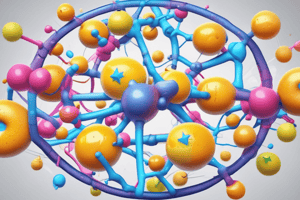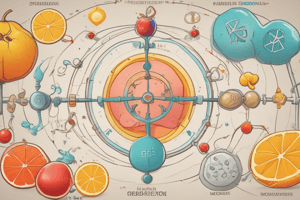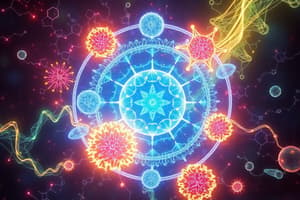Podcast
Questions and Answers
What is the breakdown of macromolecules to produce energy referred to as?
What is the breakdown of macromolecules to produce energy referred to as?
- Anabolism
- Metabolism
- Catabolism (correct)
- Glycolysis
What is the primary function of ATP in the cell?
What is the primary function of ATP in the cell?
- To synthesize macromolecules
- To store genetic information
- To replicate DNA
- To provide energy for cellular functions (correct)
What type of bond joins the first phosphoryl group to the 5-carbon sugar ribose in ATP?
What type of bond joins the first phosphoryl group to the 5-carbon sugar ribose in ATP?
- Glycosidic bond
- Peptide bond
- Phosphoanhydride bond
- Phosphoester bond (correct)
What is the sequence of metabolic reactions referred to as?
What is the sequence of metabolic reactions referred to as?
What is the primary function of glycolysis in the cell?
What is the primary function of glycolysis in the cell?
What is the term for the sum of all reactions in a cell?
What is the term for the sum of all reactions in a cell?
What is the number of phosphoryl groups that can be attached to ATP?
What is the number of phosphoryl groups that can be attached to ATP?
What is the term for the energy conversion strategy that oxidizes glucose?
What is the term for the energy conversion strategy that oxidizes glucose?
What is the molecule that is composed of a nitrogenous base, 5-carbon sugar, and one, two, or three phosphoryl groups?
What is the molecule that is composed of a nitrogenous base, 5-carbon sugar, and one, two, or three phosphoryl groups?
What is the primary purpose of Stage I in catabolism?
What is the primary purpose of Stage I in catabolism?
What is the end product of glycolysis?
What is the end product of glycolysis?
What is the primary energy source readily used by the body?
What is the primary energy source readily used by the body?
What is the role of pancreatic amylase in Stage I of catabolism?
What is the role of pancreatic amylase in Stage I of catabolism?
What is the fate of pyruvate after it is formed in glycolysis?
What is the fate of pyruvate after it is formed in glycolysis?
What is the purpose of bile salts in the digestion of fats?
What is the purpose of bile salts in the digestion of fats?
What is the role of Acetyl CoA in the citric acid cycle?
What is the role of Acetyl CoA in the citric acid cycle?
What is the process by which electrons and hydrogen atoms are harvested from Acetyl CoA?
What is the process by which electrons and hydrogen atoms are harvested from Acetyl CoA?
What is the primary function of glycolysis in cellular metabolism?
What is the primary function of glycolysis in cellular metabolism?
Which of the following enzymes is NOT a site of allosteric control in glycolysis?
Which of the following enzymes is NOT a site of allosteric control in glycolysis?
What is the fate of pyruvate in the presence of oxygen in yeast?
What is the fate of pyruvate in the presence of oxygen in yeast?
What is the purpose of recycling NAD+ in glycolysis?
What is the purpose of recycling NAD+ in glycolysis?
What is the fate of pyruvate in the presence of oxygen in mammals?
What is the fate of pyruvate in the presence of oxygen in mammals?
What is the first step in the conversion of pyruvate to CO2 + H2O in the presence of oxygen?
What is the first step in the conversion of pyruvate to CO2 + H2O in the presence of oxygen?
What is the byproduct of the complete oxidation of pyruvate to CO2 + H2O?
What is the byproduct of the complete oxidation of pyruvate to CO2 + H2O?
In which condition is pyruvate converted to lactic acid in mammals?
In which condition is pyruvate converted to lactic acid in mammals?
What is the purpose of the citric acid cycle in the complete oxidation of pyruvate to CO2 + H2O?
What is the purpose of the citric acid cycle in the complete oxidation of pyruvate to CO2 + H2O?
What is the fate of pyruvate in the absence of oxygen in yeast?
What is the fate of pyruvate in the absence of oxygen in yeast?
What is the enzyme that catalyzes the conversion of pyruvate to acetyl-CoA?
What is the enzyme that catalyzes the conversion of pyruvate to acetyl-CoA?
What is the primary function of catabolism in cellular metabolism?
What is the primary function of catabolism in cellular metabolism?
What is the molecule that serves as the universal energy currency in cells?
What is the molecule that serves as the universal energy currency in cells?
What is the term for the sequence of metabolic reactions in a cell?
What is the term for the sequence of metabolic reactions in a cell?
What is the primary function of ATP in the cell?
What is the primary function of ATP in the cell?
What is the process of breaking down glucose to produce energy referred to as?
What is the process of breaking down glucose to produce energy referred to as?
What is the term for the sum of all reactions in a cell?
What is the term for the sum of all reactions in a cell?
What is the energy conversion strategy that oxidizes glucose?
What is the energy conversion strategy that oxidizes glucose?
What is the bond that joins the first phosphoryl group to the 5-carbon sugar ribose in ATP?
What is the bond that joins the first phosphoryl group to the 5-carbon sugar ribose in ATP?
What is the breakdown of macromolecules to produce energy referred to as?
What is the breakdown of macromolecules to produce energy referred to as?
What is the primary source of energy that the body readily uses?
What is the primary source of energy that the body readily uses?
What is the purpose of Stage I in catabolism?
What is the purpose of Stage I in catabolism?
What is the result of the conversion of glyceraldehyde-3-phosphate in glycolysis?
What is the result of the conversion of glyceraldehyde-3-phosphate in glycolysis?
What is the role of pancreatic amylase in the digestion of carbohydrates?
What is the role of pancreatic amylase in the digestion of carbohydrates?
What is the purpose of Stage 2 in catabolism?
What is the purpose of Stage 2 in catabolism?
What is the fate of the acetyl group in the citric acid cycle?
What is the fate of the acetyl group in the citric acid cycle?
What is the role of serine proteases in the digestion of proteins?
What is the role of serine proteases in the digestion of proteins?
What is the primary function of glycolysis in the cell?
What is the primary function of glycolysis in the cell?
What is the purpose of bile salts in the digestion of fats?
What is the purpose of bile salts in the digestion of fats?
Which of the following enzymes does not exhibit a large decrease in free energy during glycolysis?
Which of the following enzymes does not exhibit a large decrease in free energy during glycolysis?
What is the primary reason for recycling NAD+ in glycolysis?
What is the primary reason for recycling NAD+ in glycolysis?
What is the end product of pyruvate metabolism in yeast under anaerobic conditions?
What is the end product of pyruvate metabolism in yeast under anaerobic conditions?
Which of the following reactions is not a site of allosteric control in glycolysis?
Which of the following reactions is not a site of allosteric control in glycolysis?
What is the first step in the conversion of pyruvate to CO2 + H2O in the presence of oxygen?
What is the first step in the conversion of pyruvate to CO2 + H2O in the presence of oxygen?
What is the fate of pyruvate in the presence of oxygen in mammals?
What is the fate of pyruvate in the presence of oxygen in mammals?
Which of the following is NOT a fate of pyruvate after glycolysis?
Which of the following is NOT a fate of pyruvate after glycolysis?
What is the purpose of the three control points in glycolysis?
What is the purpose of the three control points in glycolysis?
Where does the complete oxidation of pyruvate to CO2 + H2O take place?
Where does the complete oxidation of pyruvate to CO2 + H2O take place?
What is the fate of pyruvate in the absence of oxygen in mammals?
What is the fate of pyruvate in the absence of oxygen in mammals?
Flashcards
Metabolism
Metabolism
The sum of all chemical reactions that occur in a living organism, including both energy-producing and energy-consuming reactions.
Catabolism
Catabolism
The process of breaking down complex molecules into simpler ones, releasing energy in the process.
Anabolism
Anabolism
The process of building up complex molecules from simpler ones, requiring energy input.
Glycolysis
Glycolysis
Signup and view all the flashcards
Metabolic Pathway
Metabolic Pathway
Signup and view all the flashcards
ATP
ATP
Signup and view all the flashcards
Cellular Respiration
Cellular Respiration
Signup and view all the flashcards
Stage I of Catabolism
Stage I of Catabolism
Signup and view all the flashcards
Stage II of Catabolism
Stage II of Catabolism
Signup and view all the flashcards
Stage III of Catabolism
Stage III of Catabolism
Signup and view all the flashcards
Carbohydrate Digestion
Carbohydrate Digestion
Signup and view all the flashcards
Protein Digestion
Protein Digestion
Signup and view all the flashcards
Fat Digestion
Fat Digestion
Signup and view all the flashcards
Pyruvate Oxidation
Pyruvate Oxidation
Signup and view all the flashcards
Citric Acid Cycle
Citric Acid Cycle
Signup and view all the flashcards
Electron Transport Chain
Electron Transport Chain
Signup and view all the flashcards
Oxidative Phosphorylation
Oxidative Phosphorylation
Signup and view all the flashcards
Anaerobic Fermentation
Anaerobic Fermentation
Signup and view all the flashcards
Yeast Fermentation
Yeast Fermentation
Signup and view all the flashcards
Glycogenolysis
Glycogenolysis
Signup and view all the flashcards
Glycogenesis
Glycogenesis
Signup and view all the flashcards
Lipolysis
Lipolysis
Signup and view all the flashcards
Lipogenesis
Lipogenesis
Signup and view all the flashcards
Protein Catabolism
Protein Catabolism
Signup and view all the flashcards
Protein Anabolism
Protein Anabolism
Signup and view all the flashcards
Gluconeogenesis
Gluconeogenesis
Signup and view all the flashcards
Catabolic Reactions
Catabolic Reactions
Signup and view all the flashcards
Anabolic reactions
Anabolic reactions
Signup and view all the flashcards




